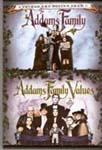

ADDAMS FAMILY
The Nature of Transitions
Any art form which has a durational aspect must deal with changes. In dance, steps have to be linked together, in music transitions have to be made from one chord to another, in comics transitions are made from one panel to another, and in films from one shot to another. The nature of the transitions between points is often as crucial as the point itself. Reading poetry and stopping at the end of each line is often a faulty transition. < Memorizing chunks of text and not being able to link them together smoothly is a similar problem.
Some Kinds of Transitions
RELATIONSHIP BETWEEN COMIC BOOK PANELS (MCCLOUD) AND SHOTS
Compare with film cuts and edits:
CROSS CUT: CROSS-CUTTING: Switching back and forth between two or more scenes in different locations that are occurring simultaneously in order to create the feeling of PARALLEL ACTION. For example, alternating between a character nearing a waterfall and another character galloping to the rescue. In cases like the above last-minute rescue, tension is often increased by shorting the shots and accelerating the rhythm of the cross-cutting. Such an editing pattern also gives the spectators access to more information than any one character in the narrative. Also called PARALLEL EDITING.
JUMP CUT: cutting together two discontinuous points of a continuous action without changing the set up. The result is that one often sees the same subject in two successive shots but in a different position. Jump cuts can be found in the films of Sergei Eisenstein, but it was Jean-Luc Godard's Breathless that created a vogue for jump cuts in the 1960s. Jump cuts are now a common feature of music videos and TV advertising.
REVERSE-ANGLE SHOT: A shot taken by a camera positioned more or less opposite from where the previous shot was taken. when reverse angles are alternated for dialogue sequences, the sequence is called SHOT/COUNTER-SHOT or SHOT-REVERSE-SHOT.
FORM CUT: Cut on shape (Janet Leigh's eye and drain in shower (Psycho)
Addams Family Values:
Cartoon of one panel variety. Family had not name. Charles Addams was creator of the cartoon
Satiric reversal of American ideal family =- eccentric wealthy and interested in the grotesque. macabre, morbid and what seems to be more than a passing interest in sado-masochism and other pain related behaviors. A close knit family with no idea they appear strange to outsiders. Very friendly and not evil. In fact rather liberal in their attitudes to all other people whom they basically respect more than just tolerate. So in a sense they have a liberal set of values which is overlaid by a rather morbid set of interests.
they seem oblivious to the fact that others think them odd. Note Gomez' line about being a lady killer (acquitted) and about Pugsley (paroled).
The family while weird is likeable - partially because of the humor and partly because they actually exemplify "family values" In no way are they dysfunctional. All the other non Addams clan seem to be.
Names
The kinship is different in the panels, T.V. series and films. Sometimes Fester is Morticia's uncle and other times Gomez' brother
The lighting in the film is critical to distinguishing the darkness of the house from the outside world of the camp and the houses where Fester goes after his marriage.
Specifically note the lighting on Morticia which invariably puts a mask like band of light across her eyes.
Costuming is largely from the comic.
Debbie's desire to change Fester, the rest of the family tries to change no one.
Compare: Debbie's self centeredness/Gary's/Addams' What kind of cuts can you find?
Single lines are like the lines under the one panel Addams Family comics.Note the use of telephoto lens to make Gary appear to be on spit over fire
Symbolism:
Music
Uses the theme song from T.V. - undergoes many metamorphesis in film
Social Comment
Theme seems to attack bigotted left wingers (who spout the doctrine) and right wingers (who oppose the doctrines). The play "A Turkey Callde Brotherhood" indicates that the brotherhood that Gary and Becky preach is a turkey. "Native Americans" (politically correct word) are held up in the play as savages etc. They refuse to accept anything which is not correct in their "world". As a result they make fun of handicapped and minorities which saying (and singing) all the politically correct things (even to singing "kumbaya" - the song popular with the Civil Rights Movement). The family seems very tolerant. Compare them with the councilors at Camp Chippewa. The camp caters to "priveleged" children (although there seem to be a number of misfits for that kind of camp there.
One aspect of the "privelege" isto be inordininately intolerant of others.
Wed. generally pokes not so gentle fun in the lines a at their attitudes:
Amanda says in the life saving lesson "I'll be the victim" to which Wed. responds "all your life".
Jokes about nose jobs and retainers for teeth are evident. In the final armeggedon at the camp, minority and disabled children generally shunned by the camp personnel are avenged.
The double plot - Fester and Debbie and what is going on between the children and parents weaves together unsteadily perhaps.
Cross cutting at the end links the demise of people who are tryig to change people: Gary and Becky and the camp (trying to change Wednesday and Pugsley) is destroyed; Debbie, who is trying to change Fester - (both from living to dead, and until she can arrange that into something more reasonable) is unmasked